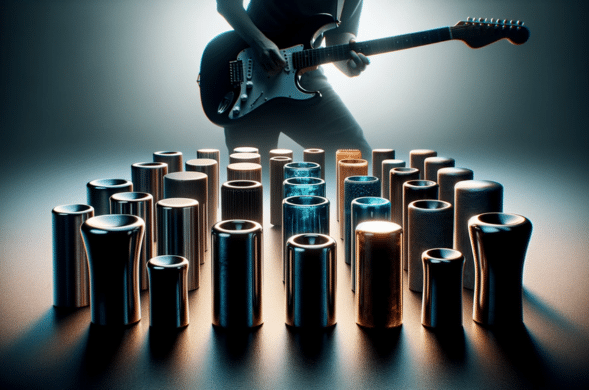Have you ever wondered, “What type of guitar slide is best for my playing style?” If so, you’re about to embark on an enlightening journey into the world of guitar slides. This article isn’t just a guide; it’s a gateway to transforming your guitar into an instrument of pure emotion and expression!
Whether you’re a seasoned player or a curious beginner, understanding the nuances of different slide materials – glass, metal, and ceramic – and their impact on your guitar’s voice is crucial. Read on to master the art of the guitar slide and find the perfect match that resonates with your musical identity.
The Short Answer
‘What type of guitar slide is best?” can vary from player to player. Glass slides offer a smooth, warm tone perfect for blues, while metal slides provide a brighter sound suitable for rock. Ceramic slides strike a balance between the two, offering versatility. Ultimately, the best slide is one that fits comfortably and complements your unique sound and technique.
Key Takeaways

Here are the essential points to remember about guitar slides.
- Material Matters: The choice of slide material (glass, metal, ceramic) significantly influences your guitar’s tone, with each offering distinct sound qualities.
- Size and Fit Are Crucial: Ensuring the right size for your guitar slide is vital for control and comfort, impacting your ability to play effectively.
- Practice Makes Perfect: Mastering the use of a guitar slide requires practice, especially for beginners, to develop control and precision.
- Adaptability: Be prepared to adjust your slide choice based on the guitar type (electric or acoustic) and the genre of music you are playing.
- Personal Preference Plays a Big Role: Your unique style and the sound you wish to create should guide your choice of guitar slide.
- Maintenance Is Key: Regular cleaning and proper storage of your guitar slide will extend its lifespan and maintain its quality.
- Experimentation Leads to Discovery: Trying out different types of slides can lead to finding the perfect match for your playing style and sound preference.
- Understanding Slide Dynamics: The weight, thickness, and length of the slide affect playability and tone, so understanding these aspects is crucial.
- Slide Technique Development: Learning specific techniques and practicing them can significantly enhance your slide guitar playing.
- Embrace the Learning Curve: Be patient with the learning process, as using a guitar slide can be challenging at first, but it’s rewarding as you progress.
Keep On Reading (Below) To Learn More
What is a Guitar Slide?
Think of a guitar slide as a bridge between your technique and the unique sound you’re aiming to get. When you slide it along the strings, it creates a continuous, fluid sound that’s become a staple in blues, rock, and beyond.
Guitar slides have a rich history, connecting modern musicians to a tradition that’s almost as old as the guitar itself. In the past, players would use anything from bone to metal to coax that signature wailing sound from their instrument. Today, we have a much broader range of materials specifically designed for guitar slides.
I’m going to introduce you to the three most common slide types: glass, metal, and ceramic. Each material brings its own flavor to your guitar’s voice. A glass slide tends to offer a smoother, warmer tone, perfect for those soulful blues. On the other hand, metal slides bring durability and a sharper sound that can really slice through a mix, whereas ceramic gives you a balanced tone with a bit of both worlds.
However, it’s not just about the materials; it’s also about the cultural and personal preferences that have shaped guitar music for decades. The choice of material reflects an artist’s desired sound and the genre they are playing. As we move to the next section, I’ll delve into the nuances of these materials and how they can color your music with different shades of tone.
Choosing the Right Material for Your Guitar Slide
Each material used in a guitar slide contributes its unique character to the sound produced. I’m going to introduce you to how these materials influence tone, which is crucial if you want your playing to stand out.
This table sums up the basics of slide materials.
| Material | Tone Quality | Durability | Best For |
|---|---|---|---|
| Glass | Warm, Smooth | Moderate | Blues, Acoustic Playing |
| Metal | Bright, Sharp | High | Rock, Punchy Blues |
| Ceramic | Balanced, Full-bodied | Moderate to High | Versatile Styles, Blending Warmth and Clarity |
Glass Slides
Glass slides deliver a warmth that’s hard to replicate with any other material. They’re perfect if you’re after a smooth, rich sound with less sustain that’s particularly suited to blues or acoustic playing. And if you’ve ever heard a glass slide on a steel-string acoustic, you know that its gentle chime can provoke an emotional response from your listeners.
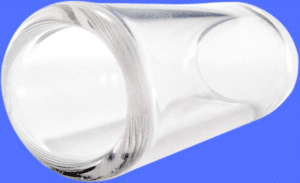
Let’s talk about a specific example – the Ernie Ball Glass Guitar Slide. It’s a testament to the quality that a good glass slide can bring to your playing. It’s thick, sturdy, and gives you that ‘brilliant chime’ on an acoustic guitar while facilitating a ‘smooth glissando’ on electric. It showcases how material choice impacts the texture and voice of your slide guitar licks.
Metal Slides
In contrast, metal slides are about durability and brighter sound. They tend to offer more sustain and a sharper attack, making them a great choice for electric guitarists looking to cut through a mix. Whether it’s chrome, brass, steel, or copper, a metal slide could be your go-to for punchy blues or rock and roll.
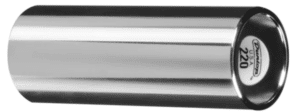
The Dunlop 220 Chromed Steel Slide is a popular choice among electric guitarists. Its main advantage lies in its robust construction, offering a bright, penetrating tone with enhanced sustain, ideal for cutting through a mix in rock and blues genres.
Ceramic Slides
Don’t think it’s all about glass and metal, though. Ceramic slides are there to bridge the gap between the warmth of glass and the clarity of metal. They give you a versatile sound that’s full-bodied and resonant without compromising on the slide’s durability.
It’s the reason ceramic is one of my favorite slide materials.
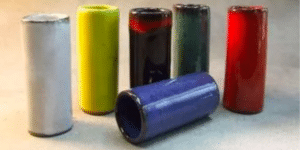
The Blues Boy Finger Slide by Rocky Mountain Slides stands out for its ceramic construction, delivering a rich, full-bodied tone. This slide expertly bridges the gap between the warm, mellow tones of glass and the bright, crisp sounds of metal, making it highly adaptable for diverse musical genres.
Now, you’re probably starting to see why material choice is more than just a practical consideration; it’s a creative decision that shapes your sound. Up next, you’re going to find out about why size also plays a pivotal role in selecting the best guitar slide for your music journey.
Size Matters: Finding the Perfect Fit for Your Slide Technique
Getting the size of your guitar slide right is just as crucial as choosing the material. That’s because the size plays a big part in how well you can control the slide on the strings and how comfortable it is to play for extended periods. You’re going to find out about why it’s important to get the fit right and how to do it.
Think of a guitar slide like a piece of tailored clothing for your finger. It doesn’t need to fit like a tight ring, but it should be snug enough so it doesn’t slip off during a passionate performance. On the flip side, too tight and you’re going to cut off circulation and make playing painful. The sweet spot? Secure, yet comfy enough to not notice it’s there after a few songs.
To get started, identify the finger you feel most comfortable using for the slide. Many players prefer their ring finger as it allows them to use other fingers for fretting. Most players experiment with different size slides until they find exactly what they’re looking for.
You can always find your ring size if you want to take a more technical approach, which can be done with a simple at-home measurement or at any jeweler. Once you have your measurements, compare them to the size chart of the slides you’re interested in. Manufacturers often provide these dimensions.
Guitar Slide Size Chart
Guitar slides are usually sized S, M, L, and XL, which refers to the inside diameter of the slide’s side.
| Slide Size | Ring Size Range |
|---|---|
| Small (S) | 4 – 7.5 |
| Medium (M) | 8 – 10.5 |
| Large (L) | 11 – 13.5 |
| Extra Large (XL) | 14 – 16 |
Just remember, a guitar slide should sit on your finger a bit looser than a standard ring would; this helps with maneuvering and quick removal, should you switch techniques mid-play.
In this process, I’ll caution you not to worry too much about perfect precision. Slides are forgiving, and once you’re used to it, the slide becomes an extension of your hand. Your focus should be on finding one that feels like a natural part of your playing.
Selecting Your Ideal Guitar Slide
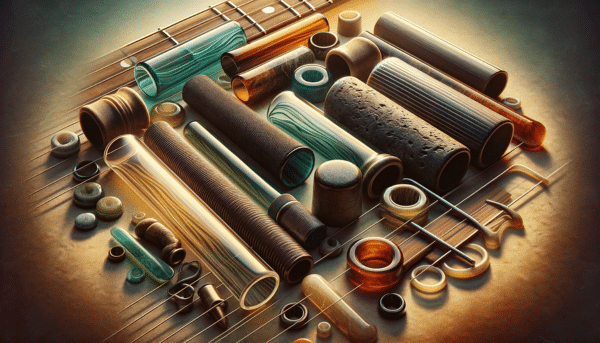
You’ve now got the inside scoop on choosing the material and size for your guitar slide and how each decision affects your playing style and the music you create. Remember, it’s not just about the tone or ease of play; it’s also about expressing yourself and your individual sound.
Embarking on the journey of mastering guitar slides is more than just a technical choice – it’s a pathway to defining your musical identity. This section aims to inspire you to use your knowledge of materials and sizes to carve out a unique sound that is distinctly yours.
Key Considerations
First, consider the emotional impact of your music. The choice of a guitar slide is not solely about the physical sound it produces; it’s about the feelings it evokes in your audience. I’d like you to reflect on the emotions you want to convey through your music and let that guide your choice. For example, a glass slide might be perfect for soul-stirring melodies, while metal could be your ally in high-energy performances.
Then, think about your playing style. Are you a guitarist who loves intricate solos or one who enjoys rhythmic strumming? Your playing style will influence the slide material and size that best complements your technique. A lighter, smaller slide might suit fast, complex playing, whereas a heavier slide could be better for sustained notes and powerful vibrato.
Remember, the journey of a slide guitarist is filled with continuous learning and adaptation. Don’t hesitate to experiment with different slides in various settings – be it a quiet room for acoustic sessions or a loud stage for electric performances. Each slide brings its own story and character to your music.
Expect the Unexpected!
Learn to embrace the imperfect and the unexpected. The beauty of slide guitar lies in its ability to surprise and captivate, both for the player and the listener. Allow yourself the freedom to explore and make mistakes – this is where your unique sound is born.
Your first attempt doesn’t need to be your last. Experiment with different slides over time to refine your style and sound. Just don’t focus too much on perfection; it’s the nuances and personal touches that make slide guitar so captivating.
Price Range of Guitar Slides
This table gives an overview of the typical price ranges for glass, metal, and ceramic guitar slides. Finding a guitar slide with the sound and performance you need is more important than splitting hairs over cost.
| Material | Price Range | Notes |
|---|---|---|
| Glass | $5 – $20 | Price varies based on thickness & brand |
| Metal | $10 – $30 | Depends on metal type and craftsmanship |
| Ceramic | $15 – $40 | Handmade pieces may cost more |
My Personal Experience With Guitar Slides: A Tale of Trial and Triumph!
Once upon a time, during a guitar practice session, I faced a challenge that changed my approach to slide guitar forever. It all started with a shiny metal slide. I thought it looked cool and would make my guitar sound amazing. But oh boy, was it tricky! Every time I slid it down the strings, it felt too heavy and made my guitar scream louder than I wanted. It was like trying to whisper using a megaphone.
Next, I tried a glass slide. It was like skating on ice – smooth and silky. But during a recording session, it slipped off my finger! It was too loose and kept getting stuck on the strings, like a car with bad brakes. Frustrated, I realized that it wasn’t just about how a slide looks or feels; it’s about how it works with my guitar and my hands.
Then came the ceramic slide, my knight in shining armor. It was a sunny day, and I was recording a new song. I slid the ceramic slide onto my finger, and magic happened. It was just right – not too heavy, not too light. It glided on the strings like a boat on calm waters, giving me warm, rich tones that were perfect for the song. It was like finding the missing piece of a puzzle.
It’s Usually A Learning Process
The ceramic slide became my go-to for both practice and performance. It didn’t matter if I was playing soft melodies or rocking out; the ceramic slide was versatile enough to handle it all. I learned a big lesson: the right guitar slide is like a good friend – it supports you, helps you express yourself, and makes music fun.
So, to all my fellow guitarists out there, remember: finding your perfect guitar slide might take some trial and error, but it’s worth it. And who knows? Maybe a ceramic slide will be your perfect match, too, or you might be more of a glass or metal slide player! Some players rotate between slide materials, depending on the need.
Either way, keep rocking and rolling, sliding and gliding, and making awesome music!
Frequently Asked Questions
Here are some of the questions I get asked about guitar slides.
If your question does not appear here, please put it in the comments, and I will get right back to you with an answer.
How Do I Clean My Guitar Slide?
Use a soft cloth with mild soap and water to clean your guitar slide. Always dry your slide thoroughly to prevent any water spots or rust.
Can I Use A Guitar Slide On Any Type Of Guitar?
Yes, you can use a guitar slide on any type of guitar, including electric and acoustic. The key is to adjust your playing technique and slide material to suit the guitar’s characteristics.
What Is The Best Way To Store Guitar Slides?
Store your guitar slides in a dry place, preferably in a padded case or a separate compartment in your guitar case. This protects the slides and prevents them from scratching or chipping your guitar’s finish during transport.
Is It Better To Use A Longer Or Shorter Guitar Slide?
The choice between a longer or shorter guitar slide depends on your playing style. Longer slides cover more strings, suitable for chords, while shorter slides offer more control for single notes and intricate playing.
Can Beginners Use Guitar Slides Effectively?
Yes, beginners can use guitar slides effectively. It’s a matter of practice and finding a slide that is comfortable in terms of size and weight.
How Important Is The Weight Of A Guitar Slide?
The weight of a guitar slide is important as it affects the pressure you need to apply on the strings. Heavier slides require less pressure but can be more challenging to control, while lighter slides offer more control but may need more hand strength.
Does The Thickness Of A Guitar Slide Affect Tone?
Yes, the thickness of a guitar slide can affect the tone. Thicker slides tend to produce a fuller, richer sound, while thinner slides offer a lighter, more delicate tone.
Can I Customize A Guitar Slide To Fit Better?
While it’s challenging to customize a guitar slide’s size, you can add internal grips like tape or rubber for a better fit. However, it’s usually best to find a slide that naturally fits well.
What’s The Difference Between Tapered And Straight Guitar Slides?
Tapered guitar slides are narrower at one end, providing a more snug fit. Straight slides have a uniform diameter that makes it easier to apply equal pressure across all the strings.
Does Finger Choice For Wearing The Slide Matter?
Yes, the finger choice for wearing the slide can matter. Most players use the ring finger for a good balance between slide control and the ability to fret other strings. Put the slide on the finger that best suits your playing style and comfort.
How Can I Improve Slide Control For Faster Playing?
To improve slide control for faster playing, practice with a lighter slide and work on your hand stability and precision. Gradually increase the speed of your playing while maintaining control.
Can I Use A Guitar Slide With Alternate Tunings?
Yes, you can use a guitar slide with alternate tunings. Slide guitar is often used in open tunings to create a more harmonious sound and make it easier to slide into the right notes.
Are There Any Specific Techniques For Playing With A Slide?
There are specific techniques for playing with a slide, such as maintaining the slide parallel to the frets and using your other fingers to mute unwanted string noise.
How Do I Avoid Unwanted Noise When Using A Guitar Slide?
To avoid unwanted noise, use your fingers behind the slide to mute the strings and control the slide pressure to ensure it doesn’t bump against the frets.
Is It Possible To Play Chords With A Guitar Slide?
Yes, playing chords with a guitar slide is possible when using certain alternate tunings. This is because placing the slide across particular strings can create commonly used chord voicings.
How Do I Transition Between Normal Playing And Using A Slide?
You can keep the slide on your little or ring finger to switch techniques quickly. You can also remove it by placing it somewhere convenient or dropping it on the floor.
What Are Some Common Mistakes To Avoid When Starting With Slide Guitar?
Common mistakes include pressing too hard with the slide, not keeping it parallel to the frets, and failing to mute unwanted strings. Start slowly and focus on the basics to avoid these pitfalls.
Should I Use A Different Slide For Electric And Acoustic Guitars?
While you can use the same slide for both electric and acoustic guitars, some players prefer using heavier slides for acoustic and lighter ones for electric to match the string tension. The choice is completely up to you. Always use the guitar slide that works and sounds best for your guitar.
Wrapping Up
So, what type of guitar slide is best for you? That’s a big question we’ve been exploring. We learned that the material of the slide – like glass, metal, or ceramic – changes how your guitar sounds. Each one has its own special tone. Glass gives a smooth sound, metal is loud and clear, and ceramic is a mix of both.
We also talked about size. Just like shoes, your guitar slide needs to fit just right. Not too tight, not too loose. It helps you control your music better. And remember, practice makes perfect! Using a guitar slide can be tricky at first, but keep trying, and you’ll get better.
I shared some tips on taking care of your slide. Keep it clean and store it safely. And don’t be afraid to try different slides. You might be surprised at what sounds best for you.
The Most Important Considerations
Selecting your ideal guitar slide is a deeply personal and artistic decision. It’s an extension of your creative expression and a tool to connect more deeply with your music. Choose with confidence, knowing that every slide brings a new opportunity to enhance your guitar playing.
Most importantly, have fun and be yourself when you play! Keep learning, and enjoy the journey of finding the perfect guitar slide!
If you want to discuss more about guitar slides or share your own experiences, I’d love to hear your feedback in the comments below.

Here’s a video from Reveb.com that talks about the types of guitar slides and illustrates the differences in sound, as well as what finger to use the slide on. Check it out!
What To Read Next ➡ Best Guitar Slides For Beginners – The Essential Guide!
Related Article ➡ Coated Vs Uncoated Guitar Strings – Which One Is Better?
Please Tell Me What You Think!
Your experiences, insights, and adventures in the world of slide guitar playing are a treasure trove waiting to be shared. Dive into the comments section and share your tales, tips, or even the challenges you’ve faced in choosing a guitar slide.
- Which guitar slide material do you prefer – glass, metal, or ceramic – and why? Share your experiences with us in the comments!
- Have you faced any challenges while learning to play with a guitar slide? We’d love to hear your stories and how you overcame them.
- Do you have a favorite brand or type of guitar slide? Let us know which one and what makes it special for you.
- What’s the one piece of advice you wish you had known when you first started using guitar slides? Help out fellow guitarists by sharing your tips!
- How has using a guitar slide changed your playing style or the music you create? Share your musical journey with us in the comments below!
- What else is on your mind?
I’m happy to answer any questions you might have!

